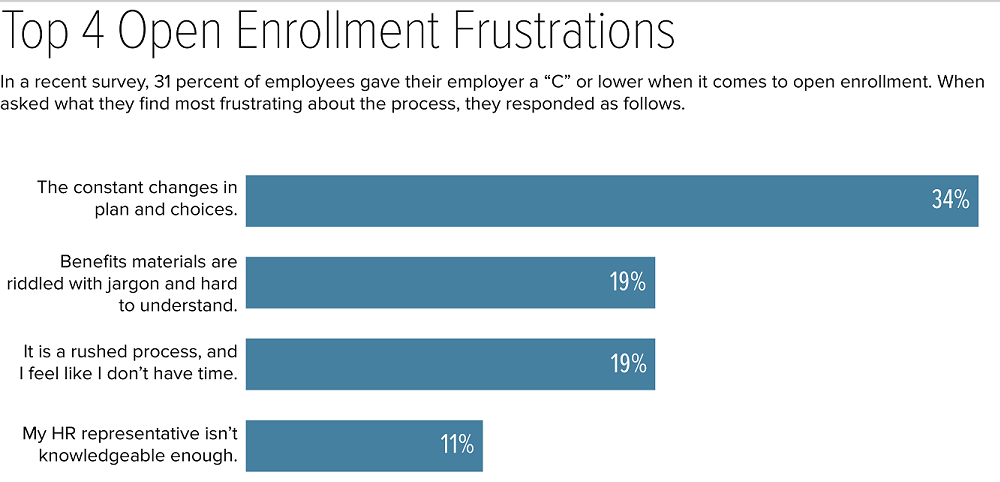This is the second in a series of articles about meeting open enrollment challenges. This article looks at developing open enrollment goals and offer tips for effective communications.
The No. 1 thing employers are doing wrong about open enrollment is a lack of preparation," said Kim Buckey, vice president of compliance communications at Birmingham, Ala.-based DirectPath, an employee engagement and health care compliance firm. "Every year there are some employers for whom open enrollment starts on Oct. 15, and they're making their last benefit decision on Oct. 1—and wondering why they can't get their materials out to employees on time."
Looking Back and Planning Forward
"It's never too late to have a post-mortem of last year's open enrollment," said Kirk McConnell, San Francisco-based product marketing lead at Collective Health, a health benefits administration firm. "Thinking back to last December, what did you tell yourselves you would never do again? Because you're going to face many of the same challenges this year."
Buckey recommended the following steps as part of open enrollment planning:
- Hold a strategy meeting with key stakeholders on the team and review what worked and didn't work last year. End the meeting with action items.
- Define objectives and how you plan to measure success. If a goal is to migrate employees from a traditional health plan to a high-deductible health plan with a health savings account, what percentage of employees should make the shift for the company to consider the migration successful?
- Address who your audiences are and what your overall and targeted messages will be. What media are you going to use? What's your timeline? What are the barriers to achieving your goals? (Targeted messages are discussed further in part three of this series.)
- Decide how you will verify whether you've reached your goals.
An Open Enrollment Checklist
Bob Armour, chief marketing officer at Jellyvision, a Chicago-based employee communication software provider, said HR departments should set some quantifiable "hard" goals based on numbers. For instance, set a goal for the number of new enrollees in a 401(k) plan or for the number of Millennials enrolled.
In addition, he said, select a few "soft" goals to make the enrollment process easier and more understandable by asking employees questions such as:
- How do you feel about your understanding of our company's benefits?
- How aware of the benefits process are you?
- How would you rate the effort required to sign up for your benefits?
"Keep the number of goals limited," Armour advised. "One to three hard and soft goals are better than eight to 10."
[SHRM members-only toolkit: Engaging in Strategic Planning]
Leverage Benefits-Use Data
HR managers can use data analytics to help employees make smarter benefits decisions, said Jeff Bakke, chief strategy officer at Minneapolis-based WEX Health, a payments technology company. "Ensure that you have year-over-year data on how benefits are being used," he advised. Having this information will help show what training or educational materials might help employees to better understand—and take fuller advantage of—underused or under-valued offerings.
"Some benefit-enrollment portals can keep track of and compare enrollment data in a way that provides meaningful insights on how employees make decisions" when selecting benefits, which can indicate where to focus consumer education during open enrollment meetings, he noted.
 Source: NamelyHR, Open Enrollment: What Employees Really Want. Results are based on responses from 517 U.S. adults employed full time. |
Think Like a Marketer
Communications planning also is vital to ensuring a successful open enrollment. When devising print and online communications, "think like a marketer," McConnell advised.
When you send an e-mail, or when printed materials are delivered to employees' homes, "You don't have five minutes of your people's attention," he noted. "You have a maximum of 30 seconds of someone's attention. Ask yourself, what are the key things they need to know?"
McConnell and Mehul Jain, a Los Angeles-based solutions consultant at Collective Health, recommended sparking employees' attention with:
- Bold graphics. "Many brokers and consultants offer communications support, or see if you can borrow some time from your design team to create a brand for your open enrollment materials," McConnell suggested. If you can't get on their busy schedule, "try an online tool like Canva, which doesn't require Photoshop skills."
- Concise content. "Ditch epically long e-mails and rely on a steady cadence of shorter e-mails to communicate the highlights and important dates for open enrollment," recommended Jain, a former benefits analyst at SpaceX, an aviation and aerospace engineering firm in Hawthorne, Calif. Bullet points are key. Use snappy language.
- Plain English. Whenever possible, supplement confusing health plan jargon with plain-English descriptions, McConnell noted. Provide a glossary to define terms familiar to benefits professionals but perplexing to many employees.
"Always highlight a call to action," McConnell advised. "If there's a specific action item, that tells someone, 'Don't just put this aside, look at it now.' "
"Blockout a few hours each week through the end of open enrollment when employees can drop by to ask questions face-to-face," advised Mark Rader, benefits communication expert at Jellyvision. He offered a bonus tip: "Make snacks available. The good kind."
This is the second in a five-part series of articles on meeting open enrollment challenges. The previous installment is Open Enrollment: Active vs. Passive Benefits Election. The third installment is Open Enrollment: Targeted Communications Address Differing Needs.
Also in this series:
Part Four: Open Enrollment: Using Social Media and Decision-Support Tools
Related SHRM Resources:
Open Enrollment Guide & Resources Page
Was this article useful? SHRM offers thousands of tools, templates and other exclusive member benefits, including compliance updates, sample policies, HR expert advice, education discounts, a growing online member community and much more. Join/Renew Now and let SHRM help you work smarter.
An organization run by AI is not a futuristic concept. Such technology is already a part of many workplaces and will continue to shape the labor market and HR. Here's how employers and employees can successfully manage generative AI and other AI-powered systems.




